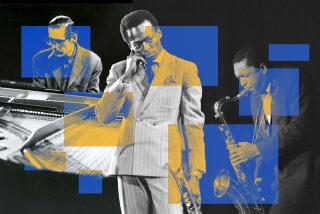Marsalis’ Mantra: ‘It’s Got to Swing’
Wynton Marsalis, confidently striding across the stage at the Disneyland Hotel, is doing his thing.
“You gotta play it, then replay, then replay it again, until you get it right,” he tells the members of the USC Studio Jazz Band. Trumpet in hand, taking the ensemble slowly and carefully through a Duke Ellington tune, Marsalis is simultaneously teacher, coach, musical partner and role model. When a phrase eludes the young musicians, he simply raises his horn to his lips and demonstrates how he wants it to be played.
“You gotta put a lot of stink on it,” he says, using highly loaded language to describe the hard-driving, gutbucket swing style he wants to hear in one passage. “That’s very important. And I’m gonna show you what I mean.”
He once again takes his trumpet and articulates the melody, stressing precisely the right notes to produce the utmost amount of swing.
“See,” he says. “You gotta pop all the notes out.”
Marsalis’ Wednesday appearance at the International Assn. of Jazz Educators Conference is the high point of the four-day event’s initial session. His high visibility as creative director of the Lincoln Center Jazz program and perhaps the best-known jazz artist in the world has drawn an overflow crowd to the Embassy Ballroom at the Disneyland Hotel complex.
Earlier in the day, he was the keynote speaker for the association’s Leadership Conference--an appropriate choice, given his continuing commitment to education and the success of his videotaped “Jazz for Young People” programs. Lecturing to an assemblage that included music teachers, bandleaders, instrumentalists and students, he repeated his often-stated mantra of the essentials of jazz--”It’s got to have soul, the feeling of blues, and it’s got to swing.”
But the meat and potatoes of Marsalis’ participation is the afternoon session--”Conducting Ellington: A Workshop for Band Directors”--an outgrowth of Jazz at Lincoln Center’s “Essentially Ellington High School Jazz Band Competition and Festival,” an annual national tournament that culminates in the selection of three high school bands to participate in an all-Ellington performance at Lincoln Center.
Marsalis works his way through some Ellington pieces, virtually measure by measure with the USC ensemble, encouraging the young players to do their best, while explaining his methods to the numerous jazz educators, as well as students, spilling into the hallway from a room designed to hold 450.
Concentrating on the trumpets, he offers them a metaphor to describe the kind of intensity he’s seeking.
“Think about those African masks, something to ward off evil. The music’s got to have that kind of intensity.”
Then, pointing to the trombone section sitting in front of the trumpets, he adds, “You have to lift your horn above the stand and play so hard that you make my man with the afro here in the trombone section turn around.”
The trumpet section, responding to Marsalis’ encouragement, begins to play with more flare, punching out the line in a fashion that reflects his initial demonstration of how it should be played. Satisfied with the results for the moment, he turns to his audience to offer more pointers on how to work with young jazz students.
“Every kid,” he says, “no matter how sad he plays, should be given a chance to play a solo. Because this is about learning. We don’t want to have to turn jazz education into what college football has become.”
Heads nod among the crowd, as some of the teachers in the audience respond affirmatively to Marsalis. But not everyone agrees completely with his meticulous method of specifying the fashion in which virtually every phrase of the Ellington piece should be played.
“He gets results,” murmurs one educator. “But it feels as though the music’s in a box, as though it has nowhere that it can move naturally.”
Another disagrees. “I don’t think so,” he says. “Listen to how much more emotion and feeling there is now over the way it sounded when these kids were playing the tune for the first time.”
The first educator shrugs. But, for the most part, the sentiment in the room is firmly supportive of Marsalis’ techniques. And when the various segments of music he has been attending to--the shouting brass, the surging rhythm section (“You’re not the stars, you’re the supporting cast”) and the carefully textured saxophones--all begin to come together, the sumptuousness of the sound is hard to dispute.
Topping off the now-assembled mosaic of sound and rhythm, he tells a trumpet soloist, “See, here’s where you can let it all hang out, get some of that stink into your solo.”
And by way of explanation, Marsalis counts off the tune for the ensemble and inserts his own solo on top, whipping out growl tones, wild runs and hard-swinging accents.
“See what I mean?” he says, as the room erupts into applause.
As the session continues, more conference attendees try to crowd into the room, and Marsalis fields questions from the audience.
Asked about fine differences between jazz styles, he responds, “I don’t have a preference for any kind of stylistic thing--so long as it swings.”
But his key point comes when he sets aside the musical specifics and offers a metaphor about improvisation as a process of attempting to come together.
“You know,” says Marsalis, “there are two important things about living in this country: You have to be yourself, and then you have to learn how to deal with other people trying to be themselves.”
* The International Assn. of Jazz Educators Conference continues through Saturday at the Disneyland Hotel, 1717 S. West St., Anaheim, with dozens of seminars, panels, recitals and concerts, many of which are open to the public. (714) 778-6600.
More to Read
The biggest entertainment stories
Get our big stories about Hollywood, film, television, music, arts, culture and more right in your inbox as soon as they publish.
You may occasionally receive promotional content from the Los Angeles Times.










